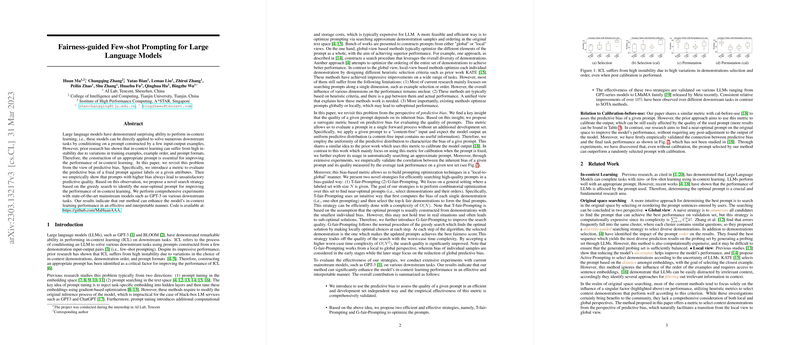Insightful Overview of "Fairness-guided Few-shot Prompting for LLMs"
The paper "Fairness-guided Few-shot Prompting for LLMs" addresses the evident instability challenges associated with in-context learning (ICL) in LLMs such as GPT-3 and BLOOM. The researchers identify that the performance of ICL is highly sensitive to variations in demonstrations, permutation, and selection, positing that the key to mitigating these issues lies in constructing prompts with minimal predictive bias.
Summary of Key Contributions
The paper introduces a novel approach to optimize prompts by evaluating and minimizing their predictive bias, proposing a surrogate metric to quantitatively assess this bias. This surrogate metric measures fairness as the uniformity of the predictive distribution when LLMs are given a "content-free" input, essentially expecting an even likelihood across all possible outputs. This method offers an efficient mechanism to gauge the quality of a prompt independent of a development set. Crucially, the paper presents two novel strategies—T-fair-Prompting and G-fair-Prompting—designed to identify the most effective prompt configurations.
- T-fair-Prompting: This approach selects top-k demonstrations ranked by their fairness score. While computationally efficient, this method is limited by its dependency on the chosen value of k, which may lead to suboptimal performance if not properly tuned.
- G-fair-Prompting: Aims to iteratively build the prompt in a greedy manner by choosing demonstrations that maximize fairness improvement at each step. Although it carries a higher computational cost than T-fair-Prompting, its comprehensive consideration of both local and global perspectives allows for more robust approximation of the optimal solution.
Empirical Validation
The authors conducted exhaustive experiments using mainstream models such as GPT-3, BLOOM, and the LLaMA series from Meta. The results substantiate their hypothesis: higher fairness scores obtained through their methods are strongly correlated with improved model performance across various benchmark datasets like SST-2, AGNews, TREC, and CoLA. Noteworthy, the G-fair-Prompting technique consistently outperformed contemporary state-of-the-art approaches, demonstrating significant accuracy gains, particularly for complex tasks like question classification.
Implications and Future Direction
This work has significant implications for deploying LLMs in practical scenarios, addressing concerns of bias and improving generalizability and robustness of AI models in downstream applications. The fairness-guided methodologies pave the way for more reliable and interpretable ICL performance. Furthermore, this research could inspire additional studies exploring other bias mitigation techniques in prompt construction, allowing for even more dynamic adaptations of LLMs to diverse tasks.
Looking ahead, integrating these fairness-guided examples with a broader ecosystem of pre-calibrated models could revolutionize how we think about model adaptability and user-centered fairness across AI applications. As LLMs continue to evolve, further exploring this alignment between fairness and performance could involve more nuanced applications to multi-modal and multilingual contexts, increasing their utility and ethical consideration at scale.
